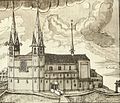Gerold Escher
Junker Gerold Escher (born October 9, 1665 , † March 5, 1738 in Zurich ) was councilor in Zurich and governor of Regensberg . He is also known as the author of a “regimental book” in which he drew numerous buildings in the city of Zurich around 1700.
Life
Gerold Escher's father was the Junker and councilor Hans Heinrich Escher. He was married to Margaretha Werdmüller († 1695) and Anna Maria Werdmüller († 1735), both of whom he survived. After a voluntary activity in the offices of the city of Zurich, he became a land clerk in the town of Weiningen . This activity left him enough time for historical research. 1709 he was appointed as eighteen of Constaffel in the Grand Council, and in 1716 the Governor of Regensberg selected. Escher died on March 5th in Zurich at the age of 73.
Regimental books
Since the 16th century, "regimental books" were written in Zurich, in which the members of the large and small councils were recorded. There were also "Alliance books" with copies of the federal leagues and "Gender books" with information about the important members of the bourgeois families. These works were mostly copied and expanded upon by young men who were preparing for a career as "regent". However, artisans are also known as the authors of such books.
Often the regimental books contained the names of the members of the small council, recorded annually, sorted by guild . The members of the Grand Council, the "Eighteen Councils" or "Twelve Councilors", were also detained less often. The bailiffs of the various offices and other officials were also listed. Sometimes these lists of names were also combined with a chronicle of the city of Zurich, in which the most important events were recorded. Sometimes the lists were adorned with images of the respective official residence, in which copper engravings from the Memorabilia Tigurina were often used.
Escher's regimental book
discovery
On the occasion of the scientific cataloging of the manuscript holdings in the Aarau Cantonal Library , employees noticed four volumes that had been found among the manuscripts of the Muri Monastery . It was the regimental book written by Junker Gerold Escher and attracted attention by its richly decorated pictures. In addition to the coats of arms of Zurich councilors, it contained numerous ink drawings of public buildings from the city and landscape of Zurich .
At the suggestion of Professor Leo Weiz, the Zurich Central Library had Elisabeth Wissler's drawings, which had become fragile and corroded by ink, restored, which made publication possible in the first place.
It is not known how the regimental book came to the Muri monastery. The work is not recorded in a catalog created in 1744, nor in later documents. At most, invoices that are in the monastery archives could provide information. However, only if the monastery purchased the volumes and did not receive them as gifts.
content
An artistically designed cover picture and an ex-libris form the introduction. In addition to numerous illustrations, for which copperplate engravings may have served as a model, Escher illustrated numerous buildings, primarily from the city of Zurich, but also from the surrounding canton. Images of buildings that were known to exist but not what they looked are particularly interesting.
The artistic value of Escher's wash pen drawings is not considered to be very significant; some errors and mistakes in perspective are too big. From the wealth of detail, however, it becomes clear that Escher wanted to reproduce what he saw as clearly as possible, and that is the real value of his documentation.
Escher began working on the books in 1693 and continued working on them until the 1720s.
gallery
literature
- Pictures from old Zurich. Public buildings and guild houses based on drawings from around 1700 from Gerold Escher's regimental book . Verlag Hans Rohr, Zurich 1954, with accompanying texts by Paul Guyer (1907–2003).
| personal data | |
|---|---|
| SURNAME | Escher, Gerold |
| BRIEF DESCRIPTION | Swiss politician, chronicler, draftsman |
| DATE OF BIRTH | October 9, 1665 |
| DATE OF DEATH | March 5, 1738 |
| Place of death | Zurich |





